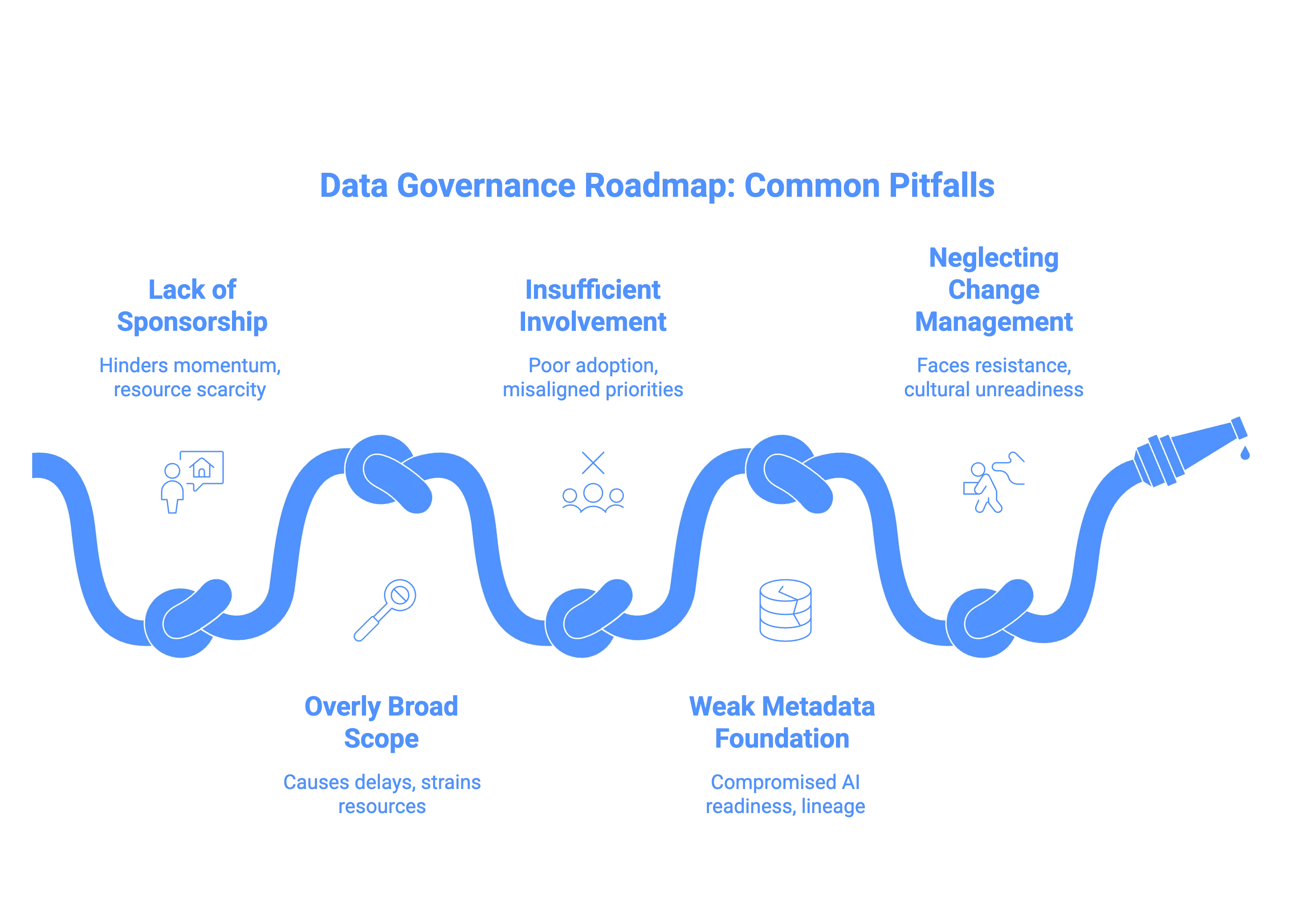How To Build a Data Governance Implementation Roadmap in 8 Steps [2025]
What are the prerequisites for building a data governance implementation roadmap?
Permalink to “What are the prerequisites for building a data governance implementation roadmap?”Summarize and analyze this article with 👉 🔮 Google AI Mode or 💬 ChatGPT or 🔍 Perplexity or 🤖 Claude or 🐦 Grok (X) .
Before you start developing your roadmap, it is important to establish a clear baseline and ensure foundational steps are complete. This includes:
- Complete a data governance readiness assessment to identify gaps that must be addressed before roadmap execution.
- Determine your data governance maturity level to build a phased and realistic roadmap, starting from where you are today.
- Secure executive sponsorship and stakeholder alignment to ensure seamless execution.
- Inventory critical data assets, including their classification, owners, lineage, and current metadata status. This baseline will guide prioritization during roadmap execution
8 step guide to create your data governance implementation roadmap
Permalink to “8 step guide to create your data governance implementation roadmap”A data governance implementation roadmap serves as a strategic guide to establish and maintain a comprehensive data governance framework that aligns with your organization’s goals and objectives.
A solid roadmap breaks your vision into specific, sequential steps.
Step 1: Identify and involve stakeholders
Permalink to “Step 1: Identify and involve stakeholders”Engage executive sponsors, business leaders, technical teams, and governance champions early.
Their buy-in is essential for ensuring long-term adoption of the program and for embedding governance principles into the organization’s culture from the start.
Step 2: Define data governance vision, objectives and goals
Permalink to “Step 2: Define data governance vision, objectives and goals”Establish a clear vision and set measurable objectives for the governance program, such as:
- Improving data quality
- Meeting compliance requirements
- Enabling AI-driven analytics
- Reducing operational risk
At this stage, outline how AI readiness will be integrated into the strategy by defining the principles, risk controls, and data quality thresholds needed for safe and effective AI use. This should include processes for:
- Monitoring bias
- Ensuring explainability
- Maintaining compliance in AI-powered systems
Step 3: Document policies, processes, roles, and responsibilities
Permalink to “Step 3: Document policies, processes, roles, and responsibilities”Establish a data governance framework and develop governance policies, standards, and procedures that outline how data will be managed and protected.
Assign clear ownership for each data domain.
Lastly, incorporate metadata management standards and a data quality framework and to ensure consistency in definitions, lineage, and stewardship across the organization.
Step 4: Set up governance tooling with role-based access controls
Permalink to “Step 4: Set up governance tooling with role-based access controls”Implement a unified control plane for data, metadata, and AI. This should include:
- A solid metadata foundation–they key for almost all forms of automation and augmentation, according to Gartner
- Automated, actionable, column-level lineage with complete visibility into data flows across your environment
- Granular access controls, personalized based on roles, domains, or projects
- Automated policy enforcement and compliance checks to minimize manual effort
- Automated classification and tag propagation
- Real-time alerts for policy violations, quality issues, unusual data activity, and more
- Support for AI governance with tools for tracking model usage, monitoring bias, ensuring explainability, and maintaining compliance reporting
All capabilities listed above should work together so that metadata, policies, and lineage are synchronized across platforms.
Step 5: Implement automation and integration
Permalink to “Step 5: Implement automation and integration”Automate repetitive governance workflows such as tag propagation, classification, and policy application.
Integrate all data sources, systems, and tools (ETL, BI, collaboration, etc.) so that metadata, policies, and lineage flow seamlessly across platforms, reducing manual effort and improving accuracy.
Step 6: Conduct training and education
Permalink to “Step 6: Conduct training and education”Run regular training programs to ensure teams understand governance policies, data handling best practices, and how to use governance tools effectively.
Include role-specific training for stewards, owners, and analysts to reinforce responsibilities and improve adoption.
Step 7: Establish monitoring, reporting, and evaluation benchmarks
Permalink to “Step 7: Establish monitoring, reporting, and evaluation benchmarks”Define the methods and metrics you will use to track governance performance.
Set up dashboards to monitor compliance rates, data quality scores, and adherence to policies in real time, enabling proactive interventions when needed.
Step 8: Set and track metrics for implementation progress
Permalink to “Step 8: Set and track metrics for implementation progress”Determine measurable KPIs such as reduction in duplicate data, increased data catalog coverage, or improvement in quality scores.
Review these periodically to assess progress, refine processes, and ensure continuous improvement in the governance program.
What are the benefits of a data governance implementation roadmap?
Permalink to “What are the benefits of a data governance implementation roadmap?”A well-defined data governance implementation roadmap ensures your governance program is strategic, measurable, and sustainable. Key benefits include:
- Improved data quality: By establishing clear standards, processes and quality standards, a roadmap ensures data accuracy, consistency, and reliability.
- Enhanced data security and privacy: Data governance practices outlined in the roadmap protect sensitive data from unauthorized access and misuse. Access controls, encryption, and monitoring are integrated from the start.
- Regulatory compliance: A roadmap ensures that governance practices meet regulatory requirements such as GDPR, CCPA, HIPAA, and other regional or industry-specific frameworks. This enhances your audit readiness.
- Better decision-making: Access to high-quality, trusted data enables better business decisions and strategic planning.
- Increased data transparency and accessibility: Governance improves transparency into data lineage, usage, and quality, while ensuring that authorized users have easy access to the data they need. This supports a stronger data-driven culture.
- AI readiness: AI initiatives require high-quality, well-documented data and clear governance rules. A roadmap strengthens AI readiness by building a strong metadata foundation that supports explainability, compliance, and trustworthy model outcomes.
- Faster time-to-value: With a roadmap, high-impact areas like compliance risks or AI readiness are addressed first, delivering early wins.
- Better stakeholder engagement: Structured milestones maintain executive sponsorship, align teams, and keep governance visible at the leadership level.
- Measurable progress and accountability: With KPIs and evaluation benchmarks built in, a roadmap makes it easy to measure progress, prove ROI, and continuously improve governance practices.
What are the most common pitfalls to avoid when building a data governance implementation roadmap?
Permalink to “What are the most common pitfalls to avoid when building a data governance implementation roadmap?”While a roadmap is a powerful tool, certain missteps can limit its effectiveness. Avoid these common pitfalls:
- Lack of executive sponsorship: Without visible support from leadership, governance programs struggle to gain momentum or secure resources.
- Overly broad scope: Trying to address every governance challenge at once can lead to delays and resource strain. Prioritize high-impact areas first.
- Insufficient stakeholder involvement: Excluding key data owners, business teams, or IT staff during planning can result in poor adoption and misaligned priorities.
- Weak metadata foundation: Metadata management is central to data governance success. Without a strong metadata layer, capabilities like AI readiness, lineage tracking, and policy enforcement will be compromised.
- Neglecting change management: A roadmap that focuses only on technical steps without addressing cultural readiness will face resistance.
- Ignoring automation opportunities: Manual governance workflows are harder to scale. Failing to plan for automation and integration early can slow progress.
- Failure to measure outcomes: Without clear KPIs and benchmarks, it becomes difficult to track improvements or demonstrate value.
- Treating it as a one-time project: Data governance is ongoing. A roadmap should include processes for continuous monitoring, feedback, and updates.

Common pitfalls in data governance implementation roadmap. Image by Atlan.
How do modern data teams ensure seamless implementation of their data governance roadmaps?
Permalink to “How do modern data teams ensure seamless implementation of their data governance roadmaps?”Modern data teams use Atlan’s unified control plane to operationalize governance from day one.
Atlan keeps data, metadata, and AI assets in sync across the stack with capabilities that include (but aren’t limited to):
- Active metadata management
- Automated, column-level lineage
- Granular role-based access
- Bi-directional tag sync across data sources
- AI governance workflows
- Real-time, automated policy enforcement
This ensures governance roadmaps move from plan to practice without bottlenecks, manual work, or compliance gaps.
Discover how a modern data governance platform drives real results
Book a Personalized Demo →Real stories from real customers: Transforming policy into practice
Permalink to “Real stories from real customers: Transforming policy into practice”
Implemented data governance strategy and roadmap using Atlan
“Our objective was to improve Aliaxis’ maturity around Data Governance, and we wanted to ensure that whatever tool we picked not only fit nicely with our tech stack, but that users didn’t feel intimidated, or felt that it was a huge organizational shift. Atlan’s user-friendliness seemed so simple and its capabilities gave us room to grow and mature as an organization without too many restrictions.”
Nestor Jarquin, Global Data & Analytics Lead
Aliaxis
🎧 Listen to podcast: Aliaxis’s global data journey with Atlan

53 % less engineering workload and 20 % higher data-user satisfaction
“Kiwi.com has transformed its data governance by consolidating thousands of data assets into 58 discoverable data products using Atlan. ‘Atlan reduced our central engineering workload by 53 % and improved data user satisfaction by 20 %,’ Kiwi.com shared. Atlan’s intuitive interface streamlines access to essential information like ownership, contracts, and data quality issues, driving efficient governance across teams.”
Data Team
Kiwi.com
🎧 Listen to podcast: How Kiwi.com Unified Its Stack with Atlan

One trusted home for every KPI and dashboard
“Contentsquare relies on Atlan to power its data governance and support Business Intelligence efforts. Otavio Leite Bastos, Global Data Governance Lead, explained, ‘Atlan is the home for every KPI and dashboard, making data simple and trustworthy.’ With Atlan’s integration with Monte Carlo, Contentsquare has improved data quality communication across stakeholders, ensuring effective governance across their entire data estate.”

Otavio Leite Bastos, Global Data Governance Lead
Contentsquare
🎧 Listen to podcast: Contentsquare’s Data Renaissance with Atlan
Discover how a modern data governance platform drives real results
Book a Personalized Demo →Ready to implement and scale your data governance roadmap?
Permalink to “Ready to implement and scale your data governance roadmap?”A data governance implementation roadmap transforms governance from an abstract goal into a structured, achievable plan.
By engaging stakeholders, defining clear objectives, embedding AI readiness, and setting up the right policies, tools, and automation, you can build and scale your governance program.
Strong metadata foundations, integrated tooling, and measurable progress tracking ensure the roadmap delivers tangible results, such as better data quality, stronger security, regulatory compliance, and readiness for AI-driven innovation.
With a modern data governance platform like Atlan, future-forward data teams can move from strategy to execution seamlessly, ensuring governance is embedded into every decision, workflow, and dataset.
Discover how a modern data governance platform drives real results - Book a personalised demo
Discover how a modern data governance platform drives real results
Book a Personalized Demo →FAQs about data governance implementation roadmap
Permalink to “FAQs about data governance implementation roadmap”How do you implement data governance?
Permalink to “How do you implement data governance?”To implement data governance, start by assessing the current state of your data governance program and gauge your maturity level. This will help in identifying the gaps from your current and desired state.
After that, engage key stakeholders and secure executive sponsorship to build and execute a data governance implementation roadmap. Clearly define and document your vision, objectives, goals, policies, processes, roles, quality standards, and metrics/KPIs.
This should be followed by tool setup, training and education, as well as protocols for continuous monitoring and improvement.
What is the roadmap for data governance?
Permalink to “What is the roadmap for data governance?”A data governance roadmap is a step-by-step plan with timelines for establishing and scaling governance practices.
It covers stakeholder engagement, vision setting, policy documentation, tooling, automation, training, monitoring, and progress measurement.
Why do you need a data governance implementation roadmap?
Permalink to “Why do you need a data governance implementation roadmap?”A data governance implementation roadmap provides a structured approach to building governance capabilities, ensuring data quality, security, and compliance.
It helps overcome challenges like data silos and inconsistent standards while aligning governance with business and AI objectives.
What are the critical success factors for realizing the data governance implementation roadmap?
Permalink to “What are the critical success factors for realizing the data governance implementation roadmap?”Key success factors include strong executive sponsorship, a clear vision aligned with business goals, a solid metadata foundation, the right tools for automation and integration, well-defined roles, stakeholder engagement, ongoing training, and measurable performance metrics.
What are common challenges faced during the implementation of a data governance roadmap?
Permalink to “What are common challenges faced during the implementation of a data governance roadmap?”Common challenges include lack of executive buy-in, unclear roles, resistance to change, poor metadata management, inadequate tooling, limited resources, and difficulty measuring impact. Addressing these early is essential for success.
What tools help streamline the implementation of your data governance roadmap?
Permalink to “What tools help streamline the implementation of your data governance roadmap?”A modern data governance platform like Atlan acts as a unified control plane for data, metadata, and AI.
Such platforms provide actionable, automated column-level lineage, granular access controls, policy enforcement, compliance automation, and real-time alerts, making governance roadmaps easier to execute and scale.
Share this article
Atlan is the next-generation platform for data and AI governance. It is a control plane that stitches together a business's disparate data infrastructure, cataloging and enriching data with business context and security.
Data governance implementation roadmap: Related reads
Permalink to “Data governance implementation roadmap: Related reads”- What is Data Governance? Its Importance, Principles & How to Get Started?
- Enterprise Data Governance — Basics, Strategy, Key Challenges, Benefits & Best Practices
- Automated Data Governance: How Does It Help You Manage Access, Security & More at Scale?
- How to implement data governance? Steps, Prerequisites, Essential Factors & Business Case
- 7 Steps to Simplify Data Governance for Your Entire Organization
- Open Source Data Governance Tools - 7 Best to Consider in 2025
- Data Governance Policy: Examples, Templates & How to Write One
- Data Governance Roles and Responsibilities: A Quick Round-Up
- Data Governance Framework — Examples, Templates, Standards, Best Practices & How to Create One?























